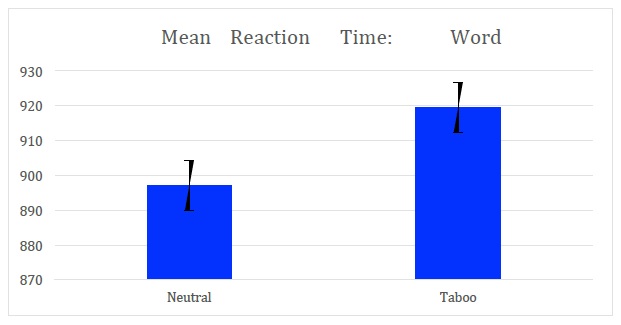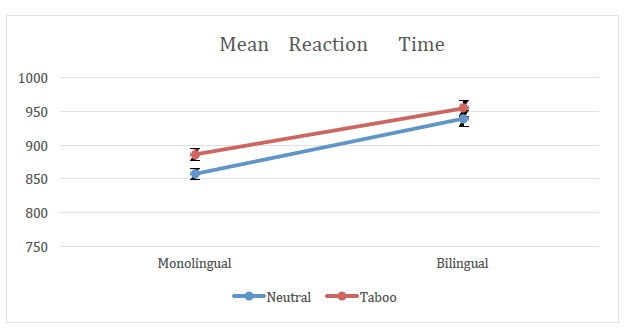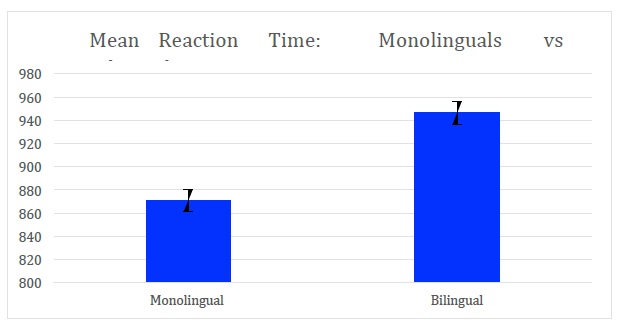RESEARCH ARTICLE
Monolinguals and Bilinguals Differ in Performance on the Taboo Stroop Task
Kayoko Okada1, *, Grace He1, Alisa Gonzales1
Article Information
Identifiers and Pagination:
Year: 2019Volume: 12
First Page: 135
Last Page: 140
Publisher ID: TOPSYJ-12-135
DOI: 10.2174/1874350101912010135
Article History:
Received Date: 09/03/2019Revision Received Date: 21/05/2019
Acceptance Date: 14/06/2019
Electronic publication date: 31/07/2019
Collection year: 2019

open-access license: This is an open access article distributed under the terms of the Creative Commons Attribution 4.0 International Public License (CC-BY 4.0), a copy of which is available at: https://creativecommons.org/licenses/by/4.0/legalcode. This license permits unrestricted use, distribution, and reproduction in any medium, provided the original author and source are credited.
Abstract
Background:
Decades of research investigating cognitive performance differences between bilinguals and monolinguals suggest that these two populations differ in executive functioning. Studies have found that bilinguals often outperform monolinguals in a variety of Executive Function (EF) tasks. However, recent reviews of the literature suggest that the bilingual advantages previously reported may be overstated, particularly when linguistic materials are used in the study.
Methods:
The present study examined differences in cognitive inhibition using emotionally charging words in a taboo Stroop task. Monolingual and bilingual native English speakers were recruited for the study. The Stroop task consisted of half neutral words and half taboo (emotional) words used in previously published studies.
Results and Conclusion:
Consistent with previous research, we found that participants were slower to respond to taboo words, and these words were better recalled than neutral words. Contrary to our initial prediction of a bilingual speed advantage, bilinguals had slower response times compared to monolingual participants. Our results lend support to the growing body of research that bilingualism does not enhance domain-general executive functioning.
1. INTRODUCTION
In a global world, knowing multiple languages can afford a variety of economic and social advantages. Currently more than 50% of the world population fluently speak more than a single language. In the United States, there has been a steady increase in bilingualism since the 1980s. Does knowing multiple languages also afford cognitive advantages? There has been a great deal of interest surrounding the “bilingual cognitive advantage” hypothesis - a hypothesis that states that speaking multiple languages strengthens executive functioning.
Early research on this subject demonstrated that bilinguals, people who regularly and fluently speak more than 2 languages, outperform monolinguals in a wide range of executive function tasks such as conflict monitoring [1-4], working memory [5, 6], task switching [7] and attentional control [8]. The well-known Stroop paradigm has been widely used to study inhibitory control and interference effects across a wide range of populations. In the classic Stroop task [9], participants are presented with colour words (GREEN) printed in different colour ink (red ink) and the task requires participants to name the colour of the ink (say “red’), ignoring the word (GREEN). Slower reaction time to incongruent stimuli (red ink of word GREEN) compared to congruent stimuli (red ink on word RED) demonstrates an interference effect due to the presen tation of conflicting information. Studies have found that bilinguals are faster than monolinguals in their ability to inhibit inappropriate stimuli [10-12]. Studies using other types of tasks such as word-learning and problem-solving have also demonstrated bilingual cognitive advantages compared to monolinguals [13-16].
The bilingual cognitive advantage presumably derives from bilinguals’ extensive experience in managing two or more languages from an early age. When multiple, competing words are activated, bilinguals must select words from the appropriate language and inhibit words from the other language. Bilinguals become practiced at switching, inhibiting, and shifting between languages, and this has lead researchers to claim that bilinguals enjoy an enhancement of domain general executive functioning.
Recent scientific reviews on this issue, however, indicate that the “bilingual cognitive advantage” may be overstated. There is a heated debate on the benefits of bilingualism and whether or not the ability to speak multiple languages enhances domain general executive functioning. One camp argues that bilingual advantages exist across domains and tasks, and that there is general enhancement of cognitive functioning. The other camp argues that the benefits of bilingualisms are more complex - that advantages, if they exist, are small and task specific. A growing number of studies support the latter view and have reported no cognitive benefits of bilingualism or have reported only small effects [4, 17-21]. A review by Paap, Johnson [21] found that the bilingual advantage was reported mostly in studies using small sample sizes but not when larger samples were used. Furthermore, analyses conducted by de Bruin, Treccani [22] reveals that a publication bias exists in the field. Studies reporting a bilingual advantage are more likely to get published than studies challenging the benefits.
The present experiment re-examine the “bilingual advantage” hypothesis using linguistic material in a taboo Stroop task. We explore whether bilinguals exert better inhibitory control over emotional linguistic stimuli compared to monolingual participants. In this task, like the colour Stroop task, participants are asked to name the colour of the ink/font that the word is presented in, and not name the word itself. However, unlike the colour Stroop task that uses colour words, the words in the taboo Stroop task are taboo words (words that elicit a strong emotional reaction). The response time to name the colour of taboo words is compared to response time to name the colour of neutral words. Studies using the emotional Stroop task demonstrate that colour naming times to emotional words are slower than colour naming times to neutral words, and therefore, taboo words are responded to more slowly than neutral words [23]. The literature suggests that in a Stroop task, emotional words produce a greater interference effect compared to neutral and positive words [24, 25]. The current study examines whether monolinguals and bilinguals differ in their ability to inhibit emotionally charging words. If bilinguals are faster or more accurate to name the colour of taboo words compared to monolinguals, this would be consistent with the bilingual advantage.
2. METHODS
2.1. Participants
Seventy participants (43 female) between 18 and 22 years of age were recruited through the Loyola Marymount University’s Human Subject Pool, and received 1 hour of course credit in exchange for their participation. All of the volunteers were native English speakers with normal or corrected-to-normal vision who primarily spoke English in daily conversation. Bilingual participants learned a second language before the age of 5 and the bilinguals’ other language varied (e.g., Spanish, French, Chinese, or Armenian). Of the seventy participants recruited, 8 participants were omitted from data analyses due to data recording error. The final analyses included 31 monolinguals and 30 bilinguals. Written informed consent was obtained from each participant prior to the study in accordance with guidelines from LMU Institutional Review Board which approved this study.
2.2. Materials & Procedure
The taboo Stroop test was created and delivered using SuperLab 5 running on an HP Elite One 800 computer with Windows 7 operating system. The experiment consisted of a total of 20 words used in previously published studies [24, 26] with an equal distribution of 10 taboo words and 10 neutral words (Table 1). These words were presented in the center of the screen and were displayed every 3 seconds. Each word was presented for 1 s in one of five font colours (blue, gray, red, green, or brown font), which was followed by a 2s rest period. Each word was presented 10 times in a randomised order for a total of 200 trials in the study. Participants were instructed to name the colour of the word, not the word itself, as quickly and accurately as possible. Participants’ vocal response times were collected using Cedrus SV-1 Smart Voice Key.
| Taboo | Nautral |
|---|---|
| 1. Bitch | 1. Bank |
| 2. Cock | 2. Cost |
| 3. Dick | 3. Dear |
| 4. Dildo | 4. Deny |
| 5. Dyke | 5. Dug |
| 6. Fuck | 6. Flew |
| 7. Pussy | 7. Pasta |
| 8. Shit | 8. Snack |
| 9. Queer | 9. Quote |
| 10. Whore | 10. Wirst |
The subjects were greeted by research assistants and explained that the study would be conducted in two parts. The first part involved filling out a variety of forms and questionnaires, and the second part involved the Stroop task. Participants filled out the Informed Consent Form, the Demographic and Personal History Questionnaire, and the Language Experience and Proficiency Questionnaire (LEAP-Q). The Demographic and Personal History Questionnaire consisted of 45 questions that asked about the students’ educational history, language background, ethnic background, handedness, family history, and hobbies. The LEAP-Q [27] was administered to obtain detailed information about language usage, cultural identity, and proficiency.
Before starting the Stroop test, participants were informed that the experiment involved the presentation of taboo words and were given the opportunity to withdrawal from the study without penalty. The participants were informed that they would see various words written in different colour font. They were instructed to name the colour that the word was presented on the computer screen, and not the word that physically appeared. The experiment started with a brief practice session that included 10 trials. The words used for the practice session were not used in the experiment. Following the practice session, there was a break in the experiment that allowed participants to withdraw from the study or ask additional questions. This was followed by 200 trials (half taboo words and half neutral words) presented in random order. In addition to recording reaction times, researchers manually recorded verbal responses on the score sheet to note any errors in overt responses. At the end of the experiment, a surprise free recall test was administered and subjects were asked to report all of the words that they remember presented during the experiment. Recalled words were transcribed by the research assistant. The study was 1 hour in length and participants were debriefed at the end of the experiment.
3. RESULTS
3.1. Reaction Time
A repeated measures ANOVA was performed by entering Word Type (Taboo and Neutral Words) as a within subjects variable and Language Condition (Monolingual vs Bilingual) as a between subject factor. Mean reaction times (ms) were calculated and compared between monolinguals and bilinguals as well as between neutral and taboo words. We found a significant main effect of Word Type (F(1,59)=14.71, p<.001, ηp2=.20) and participants were faster to respond to neutral words (M=897.18s, SD = 119.77s) compared to taboo words (M=919.52s, SD = 117.89ms). Fig. (1) illustrates the mean reaction times to name the colour of neutral and taboo words. There was not a significant interaction and monolinguals were faster at responding to both neutral and taboo words compared to bilinguals (Fig. 2). Tests of between-subjects effects yiel- ded a significant effect of Language experience (F(1,59)=7.01, p=.01, ηp2=.11). Monolinguals were significantly faster on the Stroop task compared to bilinguals (Fig. 3).
3.1.1. Word Recall
The number of words recalled in a surprise memory test were analysed using a repeated measures ANOVA with Word Type entered as a within subject variable and Language Condition entered as a between subjects factor. The mean number of words recalled was calculated and compared between monolinguals and bilinguals and between neutral and taboo words. We found a main effect of Word Type (F(1,59)=188.04, p<.001, ηp2=.76), and participants recalled significantly more taboo words (M=1.87, SD=1.07) compared to neutral words (M=4.72, SD=1.53). We did not find a significant interaction between Word Type x Language Condition, and there was no significant difference between monolinguals and bilinguals in the number of words recollected.
4. DISCUSSION
Contrary to earlier studies demonstrating a bilingual advantage, we found that bilinguals were significantly slower compared to monolinguals on the taboo Stroop task which is a task designed to test executive function and interference control. That is, we did not find a “bilingual cognitive advantage” in our young adult college population. A similar study using a Stroop task to test bilingual Spanish-speaking children also failed to demonstrate faster inhibition times in bilingual elementary school children compared to monolingual children [28]. Studies of bilingual benefits suggest that developmental differences may underlie differences in executive functioning, with older adults being more likely to demonstrate cognitive advantages [4, 29]. For example Bialystok [29] found that bilingual adults over the age of 60 showed an increase in performance on tasks of inhibitory control, however, young adults did not consistently show the advantage except in the most difficult task conditions. We recognize that performance differences may become more pronounced with aging and that subtle bilingual benefits may emerge later in life. Our limited sample cannot address this possibility, and future work should examine the longitudinal cognitive changes observed in bilingual populations.
 |
Fig. (1). Main effect of Word Type. Mean reaction times of participants to neutral and taboo words. |
 |
Fig. (2). Mean reaction time on the Stroop task. |
 |
Fig. (3). Effect of language. Difference in mean reaction times of monolinguals and bilinguals in the Stroop task. |
Our results are consistent with research suggesting that in some circumstances, bilinguals experience disadvantages, particularly in tasks that involve verbal information [30, 31]. Activating multiple words/languages comes with a cost depending on the task demands [29, 32]. This disadvantage is often documented in bilingual children and the literature suggests that some bilingual children experience reduced verbal fluency [10, 33, 34]. Our work contributes to the body of work suggesting that bilingual benefits are more complex than previously believed. The bilingual cognitive advantage may be present in some cognitive domains (e.g., set shifting, non-linguistic tasks) but it is not present across all executive function tasks.
In our study we also found that taboo words were better recalled compared to neutral words, and taboo words were responded to more slowly than to neutral words [24, 26, 35]. This pattern of results held for both monolingual and bilingual participants. Our results are consistent with the priority-binding theory that states that emotionally-salient stimuli (i.e., taboo words) are given priority in encoding and binding compared to emotionally neutral stimuli [24, 36]. Emotional memories trigger binding mechanisms that allow subjects to have an increased accuracy for contextual information. This contextual information results in enhanced memory for taboo words. Previous studies with taboo words have also shown that taboo words evoke greater physiological response compared to neutral words consistent with the claim that taboo words elicit an emotional reaction in participants [37]. For example, a study examining the effects of taboo words on skin conductance levels demonstrated that conductance levels were higher on average when taboo and negative words were presented than when positive and neutral words were presented [37]. Our results lend additional support to the findings that taboo words are better recalled than neutral words, and that taboo words create greater interference in the Stroop task compared to neutral words.
Importantly, our work supports the recent critical claims that bilingualism does not enhance general executive functioning [19, 21]. This is not to suggest that the bilingual advantage does not exist. We suggest that bilingual cognitive advantages manifest in a domain specific and task specific manner, rather than as a broad, domain free enhancement of executive functioning.
ETHICS APPROVAL AND CONSENT TO PARTICIPATE
The study was approved by LMU Institutional Review Board.
HUMAN AND ANIMAL RIGHTS
No animals were used in this research. All human research procedures followed were in accordance with the ethical standards of the committee responsible for human experimentation (institutional and national), and with the Helsinki Declaration of 1975, as revised in 2013.
CONSENT FOR PUBLICATION
Written informed consent was obtained from each participant.
AVAILABILITY OF DATA AND MATERIALS
Not applicable.
FUNDING
None.
CONFLICT OF INTEREST
The authors declare no conflict of interest, financial or otherwise.
ACKNOWLEDGEMENTS
The authors would like to thank Natalie Wong and Dina Bashoura for their help with data collection.







